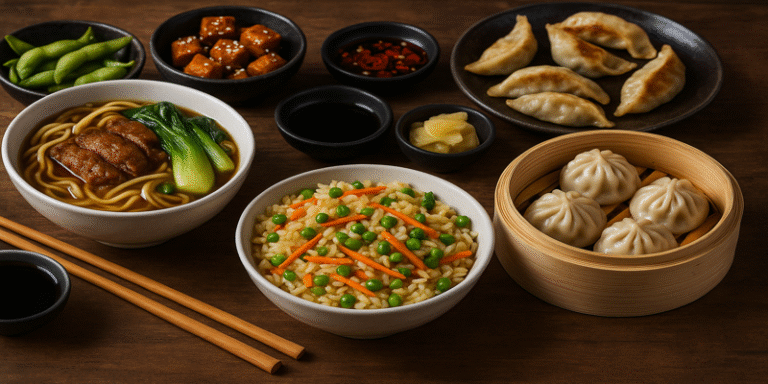The term “Oriental foods” encompasses the diverse culinary traditions of East Asia and Southeast Asia —countries including China, Japan, Korea, Thailand, Vietnam, Malaysia, and Indonesia. These cuisines, steeped in history and cultural symbolism, have evolved into global culinary icons. From dim sum and sushi to satay and kimchi, Oriental foods are admired not only for their flavour and artistry, but also for their nutritional balance, sustainability, and deep cultural meanings (Ouyang & Shang, 2025).
In recent decades, Oriental food traditions have gained global recognition for their health benefits and environmental compatibility, particularly when compared to the Western diet high in saturated fats and processed foods (Long et al., 2025). This article explores the historical, cultural, nutritional, and ecological dimensions of Oriental cuisine and its role in shaping sustainable and mindful eating worldwide.
1.0 Historical and Cultural Roots of Oriental Foods
Ancient Origins and Philosophical Foundations
The history of Oriental cuisine is intertwined with ancient philosophies such as Confucianism, Taoism, and Buddhism, which emphasise balance, harmony, and respect for nature. These beliefs shaped early approaches to dietary balance and health, evident in China’s Yin-Yang food theory, Japan’s Washoku principle, and India’s Ayurvedic system.
According to Ouyang and Shang (2025), early Chinese agricultural practices, as explained by the San Cai theory, focused on nutrient cycling and soil conservation, revealing an early understanding of sustainability and food-energy balance. These philosophies fostered cuisines that combined nutrition, taste, and spiritual well-being, where food was seen as both sustenance and medicine.
Cultural Symbolism
Food in Oriental societies holds strong symbolic significance. In China, dumplings symbolise prosperity during the Lunar New Year; in Japan, sushi represents purity and respect for natural ingredients; while in Korea, kimchi reflects communal harmony through its collective preparation and sharing (Shapiro & Cumbelich, 2025).
Thus, Oriental foods are not merely recipes—they are expressions of cultural identity, family cohesion, and social ritual.
2.0 Nutritional Profile and Health Benefits
Plant-Based Diversity
Most Oriental cuisines are predominantly plant-based, featuring grains, legumes, vegetables, soy products, herbs, and seafood. This composition aligns closely with modern nutritional guidelines promoting low saturated fats, high fibre, and phytonutrient-rich diets (Long et al., 2025).
For instance, rice, a staple across Asia, provides a foundation of complex carbohydrates, while soybean products such as tofu and miso supply plant protein and beneficial isoflavones. In traditional Chinese and Japanese diets, meals are typically low in animal fat and rich in antioxidants, contributing to lower rates of heart disease, diabetes, and obesity compared to Western populations (Wang, 2025).
Functional and Fermented Foods
Fermentation has been a hallmark of Oriental food preservation for millennia. Foods such as kimchi (Korea), miso (Japan), and tempeh (Indonesia) are naturally fermented with beneficial microorganisms, improving gut health and nutrient absorption.
A historical study by Shapiro and Cumbelich (2025) highlights the role of Neurospora crassa, a fungus used in traditional Chinese fermentation, as a sustainable source of vitamin B12 and protein. Such practices reveal the scientific ingenuity behind ancient Oriental culinary traditions long before modern nutrition science formalised them.
The Asian Paradox
Despite increased carbohydrate consumption, East Asian populations historically exhibited lower obesity rates—a phenomenon known as the Asian Paradox (Wang, 2025). This is attributed to:
- Smaller portion sizes,
- High vegetable intake,
- Active lifestyles, and
- Minimal processed foods.
Modern studies confirm that traditional Oriental diets promote longevity and metabolic resilience, aligning closely with global models of sustainable health diets.
3.0 Oriental Foods and Sustainability
Environmentally Conscious Farming
Sustainability has long been a cornerstone of Oriental food systems. Ancient Chinese agricultural texts emphasised composting, intercropping, and water conservation, practices still relevant today (Ouyang & Shang, 2025). Similarly, Japanese and Korean rice terraces are models of agroecological harmony, balancing food production with ecological preservation.
According to Long et al. (2025), analysis of over 1,000 Chinese dishes revealed that Cantonese and Sichuan cuisines typically have lower carbon footprints than Western diets due to their emphasis on seasonal vegetables, local produce, and moderate animal protein.
Zero-Waste and Whole-Food Philosophy
In many Oriental culinary traditions, nothing goes to waste. Broths are made from bones and vegetable trimmings; rice water is reused; and soy pulp (okara) becomes a secondary ingredient in soups and snacks. Such circular food practices embody the modern principles of a circular economy and zero-waste sustainability (Shapiro & Cumbelich, 2025).
Moreover, the communal and slow-cooked nature of many Oriental dishes encourages mindful eating, reducing food waste and overconsumption.
4.0 Oriental Foods in the Modern Global Context
Globalisation and Culinary Exchange
Oriental foods have achieved global popularity, with sushi, ramen, curry, and stir-fry now integral to international menus. However, globalisation also brings challenges—fusion trends and industrialisation have led to increased sugar, salt, and fat content in commercialised “Asian” foods (Khoo, 2025).
In Malaysia, for example, traditional sweet dishes have evolved into high-calorie desserts laden with refined sugars, contributing to rising obesity and diabetes rates (Khoo, 2025). This reflects the tension between cultural preservation and modern adaptation.
Oriental Foods and the Western Wellness Movement
Ironically, as traditional eating habits decline in Asia, Western health culture increasingly embraces Oriental dietary principles—such as green tea antioxidants, matcha, plant-based soy protein, and mindful eating (Wang, 2025). Nutritionists now cite Japanese and Mediterranean diets as twin pillars of longevity, both emphasising balance, portion control, and natural ingredients.
Nutrition Education and Modern Challenges
Recent research by Wang (2025) on Chinese communities adapting to Western food systems highlights the importance of nutrition education and dietary acculturation. Programmes teaching people how to cook traditional Oriental foods using local ingredients have proven effective in reducing food insecurity and promoting healthy cultural integration.
5.0 Oriental Foods as Cultural Heritage and Global Model
Culinary Diplomacy and Soft Power
Oriental cuisines have become a form of cultural diplomacy, fostering cross-cultural understanding through food. Nations such as Japan, China, and Thailand actively promote their cuisines through UNESCO heritage programmes and global culinary festivals, positioning food as both an economic asset and a cultural ambassador (Patti, 2025).
Towards a Sustainable Global Diet
The EAT-Lancet Commission (2020) recommends global diets that are predominantly plant-based, echoing the Oriental tradition of balance between humans and nature. With their emphasis on vegetable-centric meals, sustainable seafood, and cultural mindfulness, Oriental foods offer a blueprint for future food systems that nourish both people and the planet.
Oriental foods represent one of the world’s most enduring and adaptable culinary legacies—a tapestry woven from history, philosophy, nutrition, and sustainability. From the rice fields of China to the tea gardens of Japan and the spice markets of Thailand, these cuisines encapsulate a harmonious relationship between humans and their environment.
Today, as the world faces pressing challenges of diet-related diseases and environmental degradation, Oriental food traditions remind us that sustainability, balance, and mindfulness are not new ideas—they are ancient wisdom rediscovered. By embracing the essence of Oriental eating—freshness, moderation, and respect for life—humanity may rediscover a path toward healthier, more sustainable living.
References
Ouyang, H. & Shang, X. (2025). The manuring principles in ancient China from the perspective of the San Cai theory. Humanities and Social Sciences Communications, Nature Publishing.
Long, Y., Huang, L., Wang, Q., Li, Y., Shi, Z., Tan, S. & Shi, M. (2025). Environmental Footprint and Nutritional Intake of 1,000 Cantonese and Sichuan Dishes in China. Scientific Data, Nature.
Shapiro, P. & Cumbelich, W. (2025). The History of Neurospora crassa in Fermented Foods. Discover Food, Springer.
Wang, W.Y. (2025). Implementation and Evaluation of a Nutrition Education Intervention for Addressing Food Insecurity and Dietary Acculturation of Chinese Communities in New York City. Columbia University Academic Commons.
Khoo, N. (2025). Sugar, Culture and Calories: How Malaysia’s Sweet Tooth is Fuelling a Health Crisis. King’s Think Tank Spectrum Blog, London.
Patti, M. (2025). Biodiversity Conservation and Sustainable Use of Ethnobotanical Cultural Heritage. University of Calabria.









